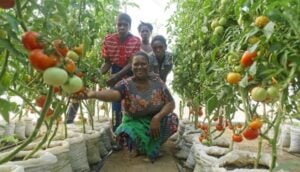CARE International’s approach to SME development includes access to finance as an important element. But we also believe that it is essential to adopt a systemic view of the market system and of the socio-economic situation of the individuals and communities with whom we work.
Our financial inclusion strategy includes the provision of credit, savings, insurance, remittance products and associated services to low-income groups, women and girls, youth and marginalized segments of society. A key element of helping these individuals and communities to lift themselves out of extreme poverty is to support the move into micro and then small enterprises.
This requires more than making cash available, so our approach has four main features:
• Improving the financial literacy of vulnerable groups. This is as important as offering access to financial services. CARE’s Village Savings and Loans Association (VSLA) members save between 30p and £3 a week each, which they pool, and then make loans to other members (between 20-30 in a group). This can have a transformative effect on their lives and on their businesses and is the starting point for an economic empowerment process. Groups provide savers and borrowers with a safe community environment in which to develop their understanding of how to use assets and credit to build businesses. When it is your neighbours who decide whether to lend you money, you need to have a pretty robust business case to explain how you will repay a loan! CARE has pioneered the promotion of VSLA groups for over 20 years, and around 4 million people are now benefiting from membership of VSLAs.
• CARE adopts graduation strategies with the beneficiaries of its economic development work where different models of economic empowerment and financial inclusion are used depending on the income situation and overall vulnerability of our target groups. The VSLAs often are the entry points of this strategy and further steps might include linkages with Formal Financial Institutions, income diversification and market linkages, enterprise development and access to formal higher value markets. A good example of this type of approach is the GRAD Project in Ethiopia, whose objective is to graduate at least 50,000 chronically food insecure households and increase each household’s income by at least $365 per year. Our Cocoa Life program in partnership with Mondel¬ēz also uses the VSLAs as an important element of the strategy to improve the position of cocoa smallholders in West Africa, by promoting livelihoods diversification.
• We rarely work with micro and small enterprises around financial inclusion only. Rather we design comprehensive socio-economic interventions across specific market systems. Agricultural Value Chains are our main target and access to credit alone may not improve micro and SME results: other possible market constraints must also be tackled, such as access to technical assistance services, quality inputs, market information, and logistic services. Having said that, Value Chain financing is also key in our strategy and we have a facilitation role in connecting the many actors in and around the value chain actors to find financing that works.
• Working with women in our experience is not only an important empowerment strategy, but it also produces better economic results for producer groups and SMEs as our Sustainable Dairy Value Chain (SDVC) program in Bangladesh demonstrates: a study contracted by CARE found that women producer groups led by women had a 12% better performance than women groups led by men, and that women livestock health workers (LHW) receiving loans had a 35% better economic performance than men LHW receiving loans.
This systemic approach necessarily involves a variety of stakeholders, both in the private and public sector. Private sector players are key as lenders, suppliers and customers. Also, in some cases the government is crucial: for instance, we have leveraged cash transfer programmes for low-income women, or government initiatives to guarantee loans for specific economic sub-sectors, thus reducing the burden of debt for smallholders.
You can find more information about CARE’s approach and programmes around Value Chain development and financial inclusion at CARE Insights.










